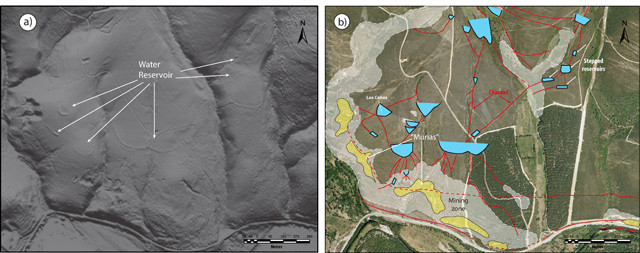
by Mary Caperton Morton Monday, February 2, 2015

Lidar maps of ancient gold mines in Spain's Erica River Valley (left), which show water channels and reservoirs used in mining operations, allow these structures to be located on aerial photos (right). Credit: J. Fernández Lozano et al.
The Romans’ thirst for gold was legendary, fueling mining operations that rival the scope and scale of modern mines. The Las Médulas mines, for example, near what is now León in northwest Spain, were massive, extending for many kilometers along the Erica River Valley. A new look at this region using lidar has revealed the extent of the ancient mining works, as well as the complex hydraulic systems used by the Romans in the first century B.C. to extract the gold.
The mines at Las Médulas have long been known about and are now a UNESCO World Heritage Site, but the use of lidar, which can see beneath vegetation, led to unprecedentedly detailed maps of the area.
“The volume of earth exploited is much greater than previously thought and the works performed are impressive … which makes this valley extremely important in the context of Roman mining [on] the Iberian Peninsula,” said co-author Javier Fernández Lozano, of the University of Salamanca in Spain, in a statement.
The Romans mined Las Médulas using a technique called “ruina montium,” which was described by the Roman writer Pliny the Elder in A.D. 77. Mine shafts were flooded with large quantities of water to break up the rock, and then placer gold was filtered out downstream.
At least seven long aqueducts, newly mapped with lidar in the study, were used to transport water to the area. The study, published in the Journal of Archaeological Science, reveals that the water systems were similar to, and perhaps modeled after, those used by the Egyptians in North Africa.
© 2008-2021. All rights reserved. Any copying, redistribution or retransmission of any of the contents of this service without the expressed written permission of the American Geosciences Institute is expressly prohibited. Click here for all copyright requests.